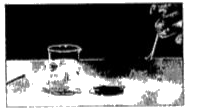On adding dilute HCl to copper oxide powder, the solution formed is blue- green. Predict the new compound formed which imparts a blue-green colour to the solution.
To solve the question of what new compound is formed when dilute HCl is added to copper oxide powder, leading to a blue-green solution, we can follow these steps:
1. Identify the Reactants:
- The reactants in this reaction are copper oxide (CuO) and dilute hydrochloric acid (HCl).
2. Understand the Reaction:
- Copper oxide is a basic oxide, and hydrochloric acid is an acid. When an acid reacts with a base, a neutralization reaction occurs, resulting in the formation of a salt and water.
3. Write the Chemical Equation:
- The reaction can be represented as:
CuO (s)+2HCl (aq)→CuCl2 (aq)+H2O (l)
- Here, copper oxide reacts with hydrochloric acid to form copper chloride (CuCl2) and water.
4. Identify the Product:
- The product formed, copper chloride (CuCl2), is a salt that imparts a blue-green color to the solution.
5. Conclusion:
- Therefore, the new compound formed that gives the blue-green color to the solution is copper chloride (CuCl2).
- The reactants in this reaction are copper oxide (CuO) and dilute hydrochloric acid (HCl).
- Copper oxide is a basic oxide, and hydrochloric acid is an acid. When an acid reacts with a base, a neutralization reaction occurs, resulting in the formation of a salt and water.
- The reaction can be represented as:
CuO (s)+2HCl (aq)→CuCl2 (aq)+H2O (l)
- Here, copper oxide reacts with hydrochloric acid to form copper chloride (CuCl2) and water.
- The product formed, copper chloride (CuCl2), is a salt that imparts a blue-green color to the solution.
- Therefore, the new compound formed that gives the blue-green color to the solution is copper chloride (CuCl2).
Topper's Solved these Questions
- CHEMICAL REACTIONS AND EQUATIONSBook:VK GLOBAL PUBLICATIONChapter:CHEMICAL REACTIONS AND EQUATIONSExercise:SHORT ANSWER QUESTIONS-II
Explore 13 Videos
- CHEMICAL REACTIONS AND EQUATIONSBook:VK GLOBAL PUBLICATIONChapter:CHEMICAL REACTIONS AND EQUATIONSExercise:LONG ANSWER QUESTIONS
Explore 5 Videos
- CHEMICAL REACTIONS AND EQUATIONSBook:VK GLOBAL PUBLICATIONChapter:CHEMICAL REACTIONS AND EQUATIONSExercise:VERY SHORT ANSWER QUESTIONS
Explore 21 Videos
- CARBON AND ITS COMPOUNDSBook:VK GLOBAL PUBLICATIONChapter:CARBON AND ITS COMPOUNDSExercise:PROFICIENCY EXERCISE (Long Answer Questions)
Explore 6 Videos
- METALS AND NON-METALSBook:VK GLOBAL PUBLICATIONChapter:METALS AND NON-METALSExercise:PROFICIENCY EXERCISE LONG ANSWER QUESTION
Explore 3 Videos
Similar Questions
On adding dilute HCl to copper oxide powder the solution formed is blue green in colour. Predict the new compound formed which imparts a blue green colour to the solution.
View SolutionOn adding dilute hydrochloric acid to copper oxide powder, the solution formed is blue-green. Predict the new compound formed which imparts a blue - green colour to the solution.
View Solution
Knowledge Check
Copper sulphate solution forms blue coloured complex with excess of ammonia. Its formula is
A[Cu(NH3)4]+3B[Cu(NH3)4]+2C[Cu(NH4)3]+2D[Cu(NH4)3]+3(A)(C9H12O)[O]−−−−−−−−→HotKMnO4PhCOOH
i. (A) does not decolourise Br2 in CCl4, reacts with Na to give a colourless and odourless gas (B).
ii. (A) does not give iodoform test.
iii. (A) is a chiral compound and oxidation of (A) with CrO3/Py gives a chiral compound (C ).
iv. The colour of Cr2O2−7 change to blue-green when added to compound (A).
The colour of Cr2O2−7 changes from orange to blue-green when added to compound (A). The blue-green colour is due to the formation of:Aa.Cr2+Bb.Cr3+Cc.CrO2−4Dd.CrO5Assertion (A): When a piece of copper metal is added to dilute sulphuric acid, the solution turns blue.
Reason (R): Copper reacts with dilute sulphuric acid to form blue copper (II) sulphate solution.ABoth A and R are true and R is the correct explanation of A.BBoth A and R are true but R is NOT the correct explanation of ACA is true but R is falseDA is false and R is true.
(a) Fresh milk has a pH of 6. When it changes into curd (yogurt), will its pH value increase or decrease ? Why ?
(b) Name the gas evolved when dilute HCl reacts with sodium hydrogencarbonate. How is it recognised ?
(c) On adding dilute hydrochloric acid to copper oxide powder, the solution formed is blue-green. Predict the new compound formed which imparts a blue-green colour to the solution.
View SolutionOn adding dilute hydrochloric acid to copper oxide powder, the solution formed is blue-green.
(a). Predict the new compound formed which imparts a blue-green colour to solution.
(b). Write a balanced chemical equation of the reaction which takes place.
(c). On the basis of the above reaction, what can you say about the nature of copper oxide?
View SolutionA small amount of a substance X is taken in a beaker and dilute hydrochloric acid is added to it slowly while stirring. The colour of the solution turns blue green.

Select the correct statements:
I. The substance X is copper oxide
II. The substance X is iron oxide
III. The blue green colour of the solution is due to the formation of copper chloride.
IV. The blue green colour of the solution is due to the formation of copper sulphate.
View SolutionIn the Lassaigne's test for the detection of nitrogen in an organic compound, the appearance of blue coloured compound is due to
View SolutionWhen a piece of zinc is added to blue copper sulphate solution, the solution becomes
View Solution